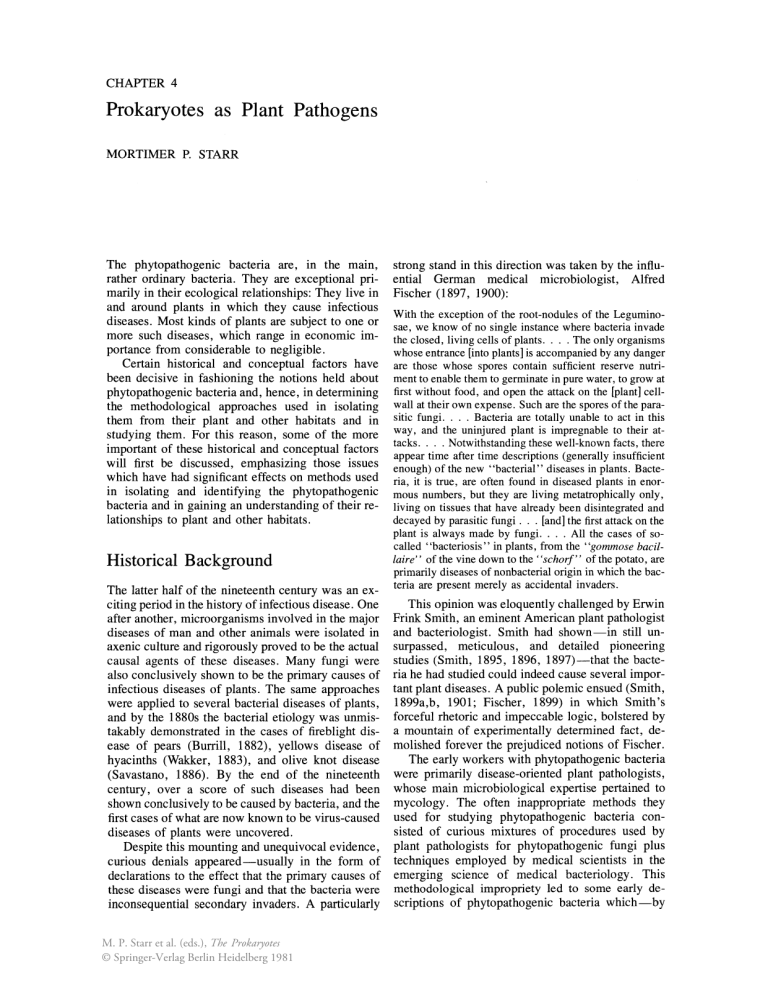
CHAPTER 4 Prokaryotes as Plant Pathogens MORTIMER P. STARR The phytopathogenic bacteria are, in the main, rather ordinary bacteria. They are exceptional primarily in their ecological relationships: They live in and around plants in which they cause infectious diseases. Most kinds of plants are subject to one or more such diseases, which range in economic importance from considerable to negligible. Certain historical and conceptual factors have been decisive in fashioning the notions held about phytopathogenic bacteria and, hence, in determining the methodological approaches used in isolating them from their plant and other habitats and in studying them. For this reason, some of the more important of these historical and conceptual factors will first be discussed, emphasizing those issues which have had significant effects on methods used in isolating and identifying the phytopathogenic bacteria and in gaining an understanding of their relationships to plant and other habitats. Historical Background The latter half of the nineteenth century was an exciting period in the history of infectious disease. One after another, microorganisms involved in the major diseases of man and other animals were isolated in axenic culture and rigorously proved to be the actual causal agents of these diseases. Many fungi were also conclusively shown to be the primary causes of infectious diseases of plants. The same approaches were applied to several bacterial diseases of plants, and by the 1880s the bacterial etiology was unmistakably demonstrated in the cases of fireblight disease of pears (Burrill, 1882), yellows disease of hyacinths (Wakker, 1883), and olive knot disease (Savastano, 1886). By the end of the nineteenth century, over a score of such diseases had been shown conclusively to be caused by bacteria, and the first cases of what are now known to be virus-caused diseases of plants were uncovered. Despite this mounting and unequivocal evidence, curious denials appeared-usually in the form of declarations to the effect that the primary causes of these diseases were fungi and that the bacteria were inconsequential secondary invaders. A particularly M. P. Starr et al. (eds.), The Prokaryotes © Springer-Verlag Berlin Heidelberg 1981 strong stand in this direction was taken by the influential German medical microbiologist, Alfred Fischer (1897, 1900): With the exception of the root-nodules of the Leguminosae, we know of no single instance where bacteria invade the closed, living cells of plants . . . . The only organisms whose entrance [into plants] is accompanied by any danger are those whose spores contain sufficient reserve nutriment to enable them to germinate in pure water, to grow at first without food, and open the attack on the [plant] cellwall at their own expense. Such are the spores of the parasitic fungi. . . . Bacteria are totally unable to act in this way, and the uninjured plant is impregnable to their attacks .... Notwithstanding these well-known facts, there appear time after time descriptions (generally insufficient enough) of the new "bacterial" diseases in plants. Bacteria, it is true, are often found in diseased plants in enormous numbers, but they are living metatrophic ally only, living on tissues that have already been disintegrated and decayed by parasitic fungi ... [and] the first attack on the plant is always made by fungi. . . . All the cases of socalled "bacteriosis" in plants, from the "gommose bacillaire" of the vine down to the "scharf" of the potato, are primarily diseases of nonbacterial origin in which the bacteria are present merely as accidental invaders. This opinion was eloquently challenged by Erwin Frink Smith, an eminent American plant pathologist and bacteriologist. Smith had shown-in still unsurpassed, meticulous, and detailed pioneering studies (Smith, 1895, 1896, 1897)-that the bacteria he had studied could indeed cause several important plant diseases. A public polemic ensued (Smith, 1899a,b, 1901; Fischer, 1899) in which Smith's forceful rhetoric and impeccable logic, bolstered by a mountain of experimentally determined fact, demolished forever the prejudiced notions of Fischer. The early workers with phytopathogenic bacteria were primarily disease-oriented plant pathologists, whose main microbiological expertise pertained to mycology. The often inappropriate methods they used for studying phytopathogenic bacteria consisted of curious mixtures of procedures used by plant pathologists for phytopathogenic fungi plus techniques employed by medical scientists in the emerging science of medical bacteriology. This methodological impropriety led to some eady descriptions of phytopathogenic bacteria which-by 124 M. P. Starr CHAPTER 4 of bacteria" in the previous sentence. Practically every phytopathologist and bacteriologist now believes that certain kinds of bacteria do indeed cause particular plant diseases and, of course, nobody believes that all kinds of bacteria cause infectious diseases of plants. Nevertheless, the view that only very few bacterial sorts are to be expected as the etiological agents in plant diseases has perhaps stultified the uncovering of new sorts of phytopathogenic bacteria. This factor is exemplified by the long delay before "mycoplasma-like" and "rickettsia-like" organisms were shown to be phytopathogenic (Hopkins, 1977; Maramorosch, 1974; Whitcomb and Tully, 1979; this Handbook, Chapters 163, 167, and 169), even though some of the plant diseases caused by these bacteria had been well-known phytopathological entities for decades. Since few of these plant mycoplasma-like and rickettsia-like creatures have yet been cultivated axenic ally (apart from the plant), a methodology quite different from standard plant bacteriology is involved. The same might be said for several of the other uncommon sorts of phytopathogenic bacteria listed in Table 1. The lesson to be gleaned from this note is the necessity for plant bacteriologists to be alert to the possible existence of nonstandard or even novel bacterial phytopathogens and, consequently, eclectic in their methodology. They must also be certain that they are working with the actual etiological agent of the disease under investigation! In connection with this latter caveat, it might be instructive to mention three recent cases. The long-sought etiological agent of Pierce's disease of grapevine has now been shown to be the Gram-negative, "rickettsia-like" (but cultivable) organism isolated by Davis, Purcell, and Thompson (1978), rather than the Gram-positive Lactobacillus sp. that was earlier announced as the pathogen (Auger and Shalla, 1975; Auger, Shalla, and Kado, 1974), which is now known to be a non phytopathogenic inhabitant of the leafhopper Conceptual Issues vector of the actual Pierce's disease agent (LatorreGuzman, Kado, and Kunkee, 1977; Purcell et aI., Several historically determined conceptual issues of 1977). The mycoplasma-like organism thought to be considerable significance need first to be considered the cause of a pea disease has now been shown to be for a proper understanding of the present methodo- a contaminant or an artifact, "probably vesicles of logical art pertaining to the phytopathogenic bac- host-cell membranes enclosing cytoplasm, riboteria. somes, and DNA-like strands"; the Mycoplasma sp. isolated from the diseased plants probably' 'orginated from animal rather than plant sources"; the etiology Diversity of Phytopathogenic Bacteria of the "pea disease may have been viral rather than bacterial" (Hampton et al., 1976). The etiological The early polemic between Smith and Fischer has agent of cadang-cadang disease of coconut has been already been noted. Once the ability of certain kinds thought, in recent years, to be one of the currently of bacteria to cause infectious disease of plants was fashionable mycoplasma-like or rickettsia-like entifirmly est~blished, no further questions have been ties; however, the latest words on the subject are that publicly raised on this general point. However, from "prokaryotes probably have no primary role in the time to time, one sees the effects of the derivative disease [and that] a virus or viroid is the most probaissue inherent in the operative words "certain kinds ble cause of cadang-cadang" (Randles et aI., 1977). modem standards-are incomplete, inaccurate, and/or irrelevant. The introduction of more appropriate bacteriological methods into bacterial phytopathology was the work of a few pioneering spirits. The most notable of these is Smith, whose several books (Smith, 1905, 1911, 1914, 1920) and hundreds of research papers and monographs-which can be traced through a biographical memoir (Jones, 1939)-laid a rational foundation for the methodological corpus. Smith, a towering intellect and experimentalist of prodigious productivity -the subject of an excellent biography (Rodgers, 1952)-introduced numerous novel procedures into phytopathogenic bacteriology, many of which are still used today. Other pioneers, whose methodological contributions during the first half of the twentieth century are notable, include Elliott (1930, 1943, 1951), Stapp (1956), Ark (1937), Israilski (1955), Burkholder (1930, 1939, 1948), and Dowson (1949, 1957). All of these individuals were basically plant pathologists with a strong expertise in bacteriology. An explosive worldwide development of the field, evident during the 1950s and 1960s, continues unabated today (see, for example, Maas Geesteranus, 1972; Station de Patho10gie Vegetale et Phytobacteriologie, 1979). Nowadays, most good university departments and research institutions of plant pathology include one or more expert bacteriologists who are also competent phytopathologists. However, another trend can be perceived in that there are sometimes bacteriologists and biochemists who work with phytopathogenic bacteria without knowledge or appreciation of plant pathology and without adequate liaison in phytopathological matters. One must never lose sight of the fact that the major uniqueness of phytopathogenic bacteria resides in their ability to cause diseases of plants.

